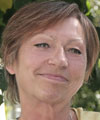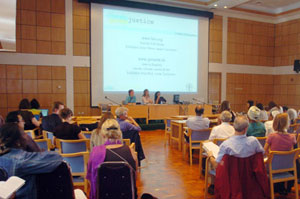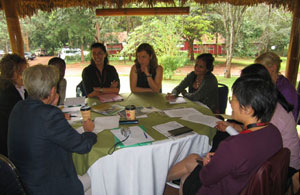Tiempo Climate Cyberlibrary
Slow Progress on Integration of Gender Issues
- Tiempo archive
- Complete issues
- Selected articles
- Cartoons
- Climate treaty
- Latest news
- Secretariat
- National reports
- IPCC
About the Cyberlibrary
The Tiempo Climate Cyberlibrary was developed by Mick Kelly and Sarah Granich on behalf of the Stockholm Environment Institute and the International Institute for Environment and Development, with sponsorship from the Swedish International Development Cooperation Agency.
While every effort is made to ensure that information on this site, and on other sites that are referenced here, is accurate, no liability for loss or damage resulting from use of this information can be accepted.
 |
Ulrike Röhr reports on the current state of progress made on integrating gender issues into the climate treaty negotiations, most recently at the Twelfth Conference of the Parties (COP12) in November 2006. |
| The author is director of genanet - focal point on gender, environment and sustainability, which aims to integrate gender justice within the climate treaty process and other environmental and sustainability policies. Her primary areas of responsibility are gender issues in energy and climate change. | |
In 2003, at the United Nations Framework Convention on Climate Change (UNFCCC) Ninth Conference of Parties (COP9) in Milan, Italy, an informal network of women and some men was formed composed of individuals interested in integrating gender issues into climate change policies and negotiations. We all brought to the network different interests and areas of work from various regions of the world, but were united in our commitment to ensure that women's voices were heard in the climate change debate.
Since then, our network has organized side events during the annual UNFCCC Conferences of the Parties. At these events, we have informed participants about the linkages between gender and climate change at our exhibition stands and held women's meetings during the Conferences as well as submitting statements in the Plenary Sessions. Compared to gender-related activities before COP9, that's a lot! Although compared to our goal of mainstreaming gender concerns into the climate change debate, progress is still moving at a snail's pace.
Progress is being achieved very slowly and is mainly constrained by two realities. First, there are too few women and men participants whose main focus is on gender issues and who are also willing to lobby for gender mainstreaming. Second, there is a huge lack of sex-disaggregated data and gender-aware research in the area of climate change and climate protection, a fact that limits the quality of discussions that can be held at a negotiation level.
A first step has recently been undertaken which aims to close this gap. LIFE/genanet is conducting a research project to review, analyse and assess existing research in order to develop a comprehensive overview of data and knowledge relevant to gender aspects of climate change in mitigation and adaptation, including identifying strategically important knowledge gaps. The review will consider research done under the heading of "gender and climate change" as well as research in other disciplines and fields linked to climate change policy. In addition, the project aims to consolidate contacts and networks within the research community and develop a database of experts on gender and climate change. The project is being conducted in cooperation with, and is funded by, the Food and Agriculture Organization of the United Nations.
 |
Gender and climate side event, COP12 |
The first results of the project were presented during a side event at COP12 in Nairobi, November 2006.
At the side event, Yianna Lambrou, senior officer at the Food and Agriculture Organization explained the commitment of her organization to mainstreaming gender issues in all of its work, such as on energy, agriculture, fisheries and forestry, and emphasised the importance of pursuing gender equality in climate change. She introduced preliminary results of the literature review on the gender aspects of climate change and invited participants to provide feedback and inputs so that the final result will be as comprehensive as possible.
After a brief explanation of the terms ‘gender' and ‘gender roles', the present author highlighted the observation that an underlying assumption of the project was that there might be more data in existence than originally thought, especially when looking at climate policy, energy, agriculture, water or biodiversity. Such data might not be linked directly to climate change yet - but this could easily be done. This was the initial assumption of the researchers but, unfortunately, reality proved otherwise. Since the beginning of the project in August 2006, preliminary findings indicate that there are more case studies than we expected, but there is very little large-sample quantitative research.
Minu Hemmati from LIFE/genanet outlined the five steps undertaken so far to develop an analytical framework on gender in climate change.
- STEP 1: Identify climate change topics. That is, identify sectoral and cross-sectoral issues that are impacting the climate and/or are impacted by climate change, and/or are results of climate change.
- STEP 2: Identify the gender aspects of the topics identified in STEP 1, such as known facts and open questions.
- STEP 3: Identify the dimensions that are involved in looking at the gender aspects identified in STEP 2, and in which disciplines the relevant research is being done and/or should be done.
- STEP 4: Identify what research exists, and where there are gaps. What do we know that needs to be integrated into climate policy making and what don't we yet know that needs to be addressed in future research?
- STEP 5: Identify priority issues for future research.
Currently, the project has identified 609 individual sources, 215 of those of immediate relevance. Next steps to be undertaken include continuing the research review by interviewing researchers who are working directly on gender and climate change issues, examining additional scientific databases, and applying the analytical framework to all sectoral and cross-sectoral issues as well as to the effects of climate change on gender equality.
A report identifying available knowledge and gaps is being published by the Food and Agriculture Organization midway through 2007.
The project is searching for further data on gender and climate change and looking for publications and projects that may have been missed, as the data collection process ended in January 2007. Relevant materials can be sent to the address below. At this stage of the project, we will not be able to integrate new materials into the final report but they will be included in the database that the project has created.
Discussion at the side event that followed the speakers' presentations noted that additional research and issues should be taken into account. For example, who decides about the purchase of energy efficient stoves in rural households and is the consent of men required for women to utilize the stoves? It was noted that decision-making power is gender-based - a key issue for the UNFCCC negotiations on technology transfer. Another challenge raised during the discussion was how to interest more men to committing themselves to applying gender mainstreaming strategies in climate change work.
Though progress in the field of data collection, as well as in the overall sensitization on gender issues, has been at snail's pace, there are some positive signs.
Environmental organizations have been especially resistant in the past to incorporating gender issues in their work. But, with time, we have seen that the inclusion of gender concerns in their policies and approaches is becoming increasingly present, particularly when looking at climate change from a human rights, justice and equity perspective. For example, Friends of the Earth International and its members are combining advocacy for environmental protection with human rights and justice arguments.
An example of a recent initiative is a position paper prepared by the Global Forest Coalition entitled Biofuels: A Disaster in the Making which has been endorsed by more than one hundred organizations and individuals. The paper calls upon the Parties to the UNFCCC to immediately suspend all subsidies and other forms of inequitable support for the import and export of biofuels and calls especially upon industrialized countries to recognize their responsibility for destroying the planet's climate system.
The paper describes the harmful effects of rapidly increasing demands for crops like corn, palm oil or soy as a source for biofuel, such as increased land competition leading to marginalization of small-scale agriculture. The paper also explains that arable land used to grow food is now being used to grow fuel, leading to staggering food prices and causing hunger, malnutrition and impoverishment among the poorest sectors of society. It points out the destruction of traditions, cultures and values of indigenous peoples and rural communities. The paper highlights that these effects have particularly negative impacts on women and indigenous peoples who are economically marginalized and who are most dependent on natural resources like water and forests.
The increasingly present and growing voice of young people who are involved in the UNFCCC negotiations should also be highlighted. These young people are much more aware of gender inequalities than most other constituencies, emphasizing in their communiqués and other formal interventions the importance of taking into account gender equity and following up with concrete action.
We hope that more environmental organizations will take note of these examples and will be encouraged to integrate gender into their own communiqués and position papers.
What is still greatly lacking is building a nexus between gender knowledge in climate change and the concrete issues of the negotiations in detail, as well as a linkage to the implementation of the Kyoto Protocol and the UNFCCC.
In Nairobi, it was noticeable that the social aspects of climate change and climate protection were often addressed in side events and debates. This might be due to the venue of the conference; for the first time, a UNFCCC conference was held in sub-Saharan Africa, putting the whole continent at the centre of the world's attention. The impacts of climate change and their linkages to poverty reduction were put on the agenda, particularly in the context of Africa. Unfortunately, gender aspects were only rarely taken into account in these debates. Nevertheless, the broadening of the debates with the inclusion of social and inequity aspects in discussions otherwise focusing mostly on the economic, technical and natural science dimensions of climate change is an encouraging, strong entry point for gender perspectives as well.
The hope for greater emphasis on gender mainstreaming in climate protection and climate change is nourished by several good examples that came up in Nairobi. The CARE Brazil Social Carbon Fund, a partnership between CARE Brazil and global brokers CO2e was launched at the conference. In the presentation of the Fund at COP12, it was discussed how local women's projects might benefit. The methodology was based on a strong gender approach. It was agreed to carry out a pilot project, aimed at identifying options at both ends, for women's projects and for seeking donor funding.
 |
Women's Caucus, COP12 |
During the meetings of the Women's Caucus at COP12, a first draft of a lobbying paper, identifying connections and entry points for strengthening the gender aspects in some of the issues negotiated in Nairobi and beyond, was discussed.
The paper addresses, amongst other things, adaptation, the Clean Development Mechanism, capacity building, public awareness and information, and market-based approaches in general. It protests that the main victims of market-based approaches to environmental protection are those who do not have the cash to buy their water, fuel wood and medicines. They include women, indigenous peoples, landless farmers and the cash-poor in general. These same people also lack formal land titles, marketing skills, investment capital and the technical information they would need if they wished to compete in the environmental services markets. In addition, the challenge of equitable access to energy, which is particularly important for rural women and the urban poor, is not likely to be resolved through market-based mechanisms. In view of this, the Women's Caucus called for a careful analysis of positive and negative effects on all potential market actors for all market-based approaches. Moreover, the Women's Caucus plans to develop a common submission to the UNFCCC adaptation committee regarding gender issues in climate change debates.
We hope that results of the LIFE/genanet and Food and Agriculture Organization research review will put these activities on a more substantiated base, supported by the literature, in the future.
Further information
Ulrike Röhr, genanet - focal point on gender, environment and sustainability, LIFE eV, Dircksenstr. 47, D-10178 Berlin, Germany. Fax: +49-30-30879820. Email: roehr@life-online.de. Web: www.genanet.de.
In the Cyberlibrary
The Tiempo Climate Cyberlibrary lists sites that cover gender and climate change.
On the Web
The genanet and FAO websites contain information and resources on the issue of gender, climate and development. Any individual or organization who wants to join the network or wishes to participate in the mailing list on gender and climate change, should contact the author by mail at the address above. Further information about the CARE Brazil Social Carbon Fund is available.
Bright Ideas

General Electric plans to cut solar installation costs by half

Project 90 by 2030 supports South African school children and managers reduce their carbon footprint through its Club programme

Bath & North East Somerset Council in the United Kingdom has installed smart LED carriageway lighting that automatically adjusts to light and traffic levels

The United States National Oceanic and Atmospheric Administration and the American Public Gardens Association are mounting an educational exhibit at Longwood Gardens showing the link between temperature and planting zones

The energy-efficient Crowne Plaza Copenhagen Towers hotel is powered by renewable and sustainable sources, including integrated solar photovoltaics and guest-powered bicycles
El Hierro, one of the Canary Islands, plans to generate 80 per cent of its energy from renewable sources

The green roof on the Remarkables Primary School in New Zealand reduces stormwater runoff, provides insulation and doubles as an outdoor classroom

The Weather Info for All project aims to roll out up to five thousand automatic weather observation stations throughout Africa

SolSource turns its own waste heat into electricity or stores it in thermal fabrics, harnessing the sun's energy for cooking and electricity for low-income families

The Wave House uses vegetation for its architectural and environmental qualities, and especially in terms of thermal insulation

The Mbale compost-processing plant in Uganda produces cheaper fertilizer and reduces greenhouse gas emissions

At Casa Grande, Frito-Lay has reduced energy consumption by nearly a fifth since 2006 by, amongst other things, installing a heat recovery system to preheat cooking oil
Updated: May 15th 2015